Attached files
| file | filename |
|---|---|
| 8-K - FORM 8-K - KERYX BIOPHARMACEUTICALS INC | d306682d8k.htm |
| EX-99.1 - EX-99.1 - KERYX BIOPHARMACEUTICALS INC | d306682dex991.htm |
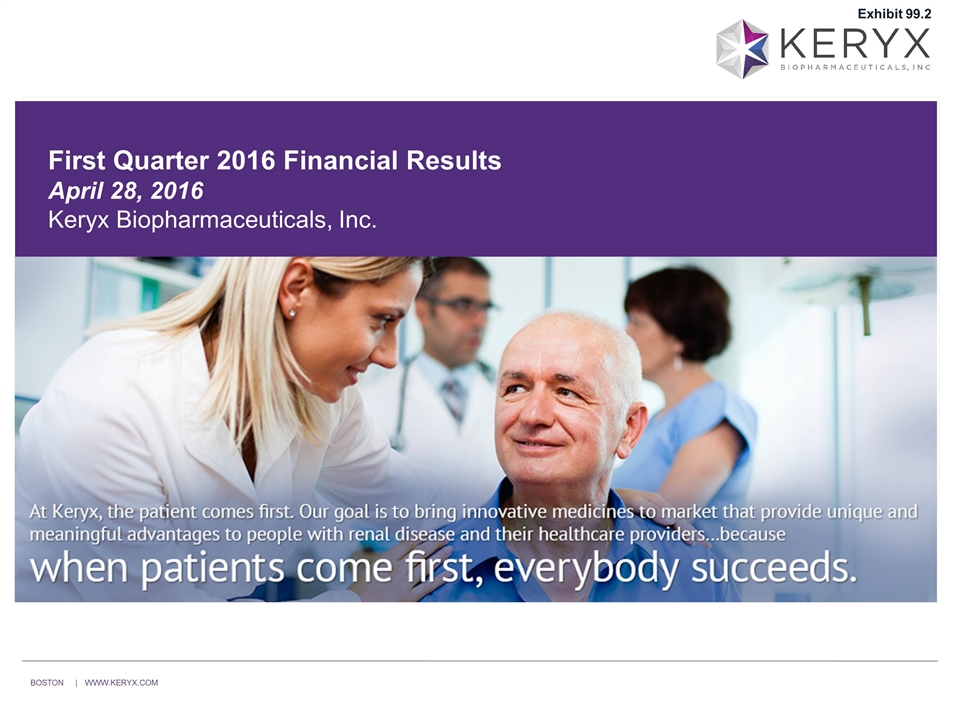
First Quarter 2016 Financial Results April 28, 2016 Keryx Biopharmaceuticals, Inc. Exhibit 99.2
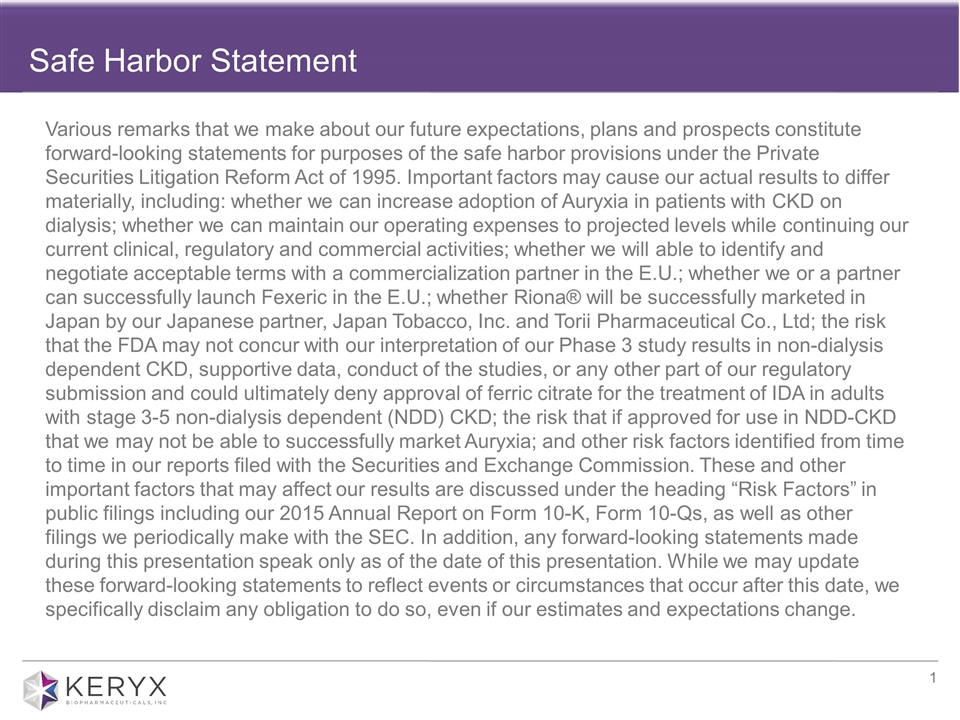
Safe Harbor Statement Various remarks that we make about our future expectations, plans and prospects constitute forward-looking statements for purposes of the safe harbor provisions under the Private Securities Litigation Reform Act of 1995. Important factors may cause our actual results to differ materially, including: whether we can increase adoption of Auryxia in patients with CKD on dialysis; whether we can maintain our operating expenses to projected levels while continuing our current clinical, regulatory and commercial activities; whether we will able to identify and negotiate acceptable terms with a commercialization partner in the E.U.; whether we or a partner can successfully launch Fexeric in the E.U.; whether Riona® will be successfully marketed in Japan by our Japanese partner, Japan Tobacco, Inc. and Torii Pharmaceutical Co., Ltd; the risk that the FDA may not concur with our interpretation of our Phase 3 study results in non-dialysis dependent CKD, supportive data, conduct of the studies, or any other part of our regulatory submission and could ultimately deny approval of ferric citrate for the treatment of IDA in adults with stage 3-5 non-dialysis dependent (NDD) CKD; the risk that if approved for use in NDD-CKD that we may not be able to successfully market Auryxia; and other risk factors identified from time to time in our reports filed with the Securities and Exchange Commission. These and other important factors that may affect our results are discussed under the heading “Risk Factors” in public filings including our 2015 Annual Report on Form 10-K, Form 10-Qs, as well as other filings we periodically make with the SEC. In addition, any forward-looking statements made during this presentation speak only as of the date of this presentation. While we may update these forward-looking statements to reflect events or circumstances that occur after this date, we specifically disclaim any obligation to do so, even if our estimates and expectations change.

Non-GAAP Financial Measures To supplement the financial measures presented in our press release and related conference call, and in accordance with accounting principles generally accepted in the United States (“GAAP”), Keryx also presents expected cash operating expenses in the 2016 financial guidance discussion, which is a non-GAAP financial measure. This non-GAAP financial measure’s most comparable GAAP financial measure is total operating expenses. Keryx believes that the non-GAAP financial measure cash operating expenses provides investors with useful information regarding the company’s financial condition and prospects because this measure helps an investor better understand the company’s expected liquidity needs. Also, this non-GAAP measure is used by Keryx management for internal review of the company’s operating performance. A “non-GAAP financial measure” refers to a numerical measure of the company’s historical or future financial performance, financial position, or cash flows that excludes (or includes) amounts that are included in (or excluded from) the most directly comparable measure calculated and presented in accordance with GAAP in the company’s financial statements. Keryx provides the non-GAAP measure listed above as additional information relating to Keryx’ expected operating results as a complement to results provided in accordance with GAAP. The non-GAAP financial information presented here should be considered in conjunction with, and not as a substitute for or superior to, the financial information presented in accordance with GAAP. There are significant limitations associated with the use of non-GAAP financial measures. Further, these measures may differ from the non-GAAP information, even where similarly titled, used by other companies and therefore should not be used to compare Keryx’ performance to that of other companies.
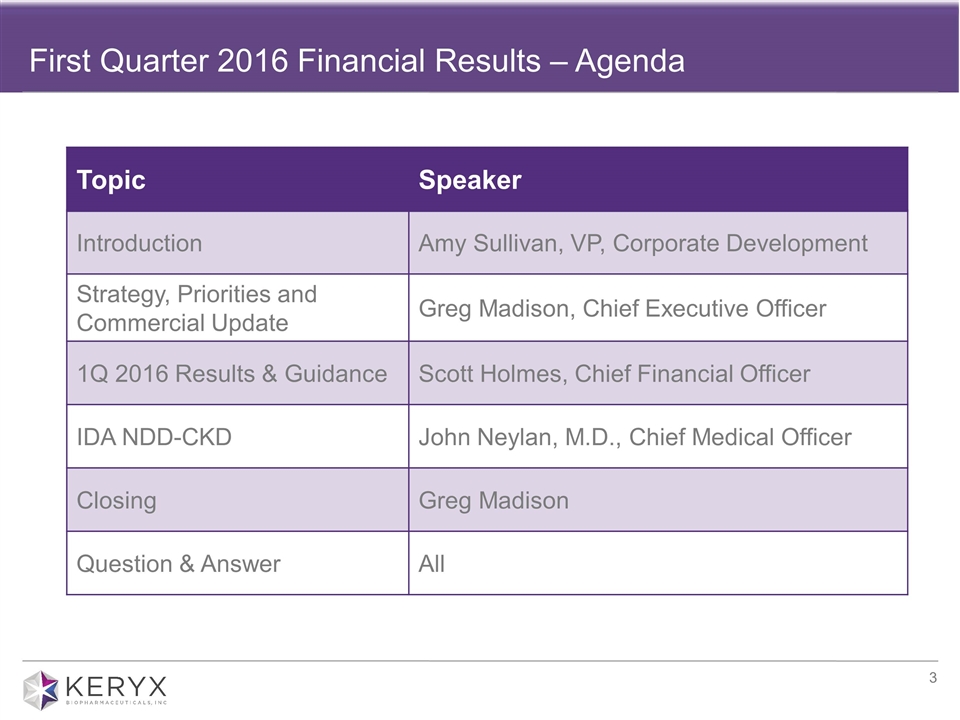
First Quarter 2016 Financial Results – Agenda Topic Speaker Introduction Amy Sullivan, VP, Corporate Development Strategy, Priorities and Commercial Update Greg Madison, Chief Executive Officer 1Q 2016 Results & Guidance Scott Holmes, Chief Financial Officer IDA NDD-CKD John Neylan, M.D., Chief Medical Officer Closing Greg Madison Question & Answer All

Building a Foundation for Long-Term Growth SOLID FUNDAMENTALS ESTABLISHED 2015 2017 POTENTIAL IDA APPROVAL 2016 DRIVE DIALYSIS ADOPTION AURYXIA: A NEW TREATMENT CATEGORY Leverage field team expansion Increase utilization Increase breadth & depth of prescribing Generate further data to support differentiation Drive awareness of IDA in pre-dialysis Educate physicians on treatment guidelines 2017 POTENTIAL IDA APPROVAL Built brand awareness Refined sales messaging Introduced samples Established reimbursement Expanded field team * Auryxia is currently indicated for the control of serum phosphorus levels in CKD patients on dialysis; **Ferric citrate is being evaluated for use in non-dialysis dependent CKD patients as a treatment for iron deficiency anemia.
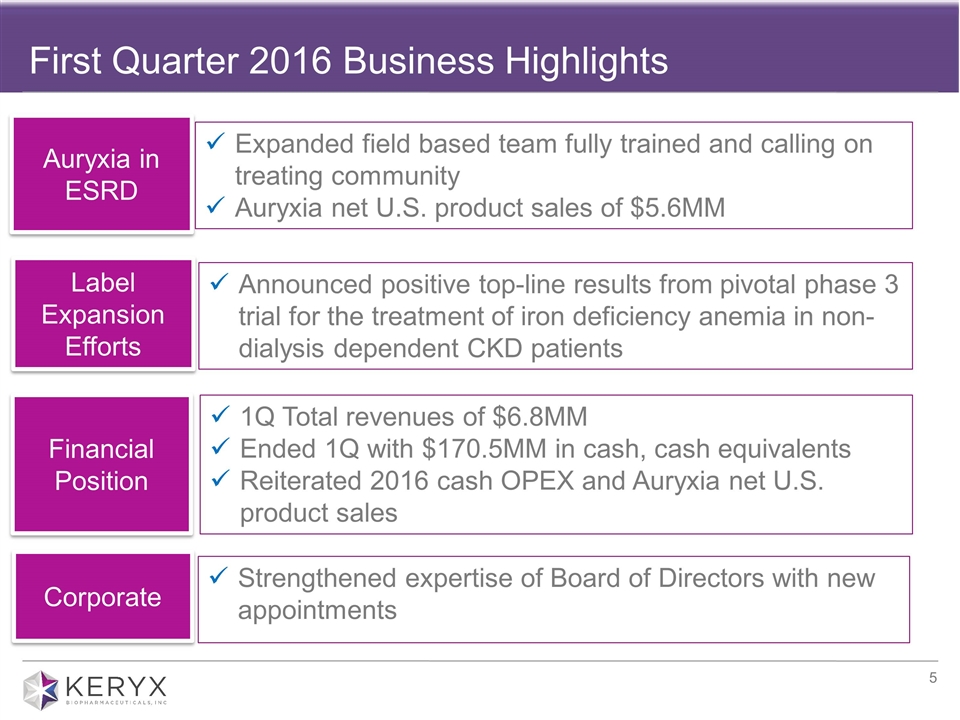
First Quarter 2016 Business Highlights Expanded field based team fully trained and calling on treating community Auryxia net U.S. product sales of $5.6MM Announced positive top-line results from pivotal phase 3 trial for the treatment of iron deficiency anemia in non-dialysis dependent CKD patients 1Q Total revenues of $6.8MM Ended 1Q with $170.5MM in cash, cash equivalents Reiterated 2016 cash OPEX and Auryxia net U.S. product sales Auryxia in ESRD Label Expansion Efforts Strengthened expertise of Board of Directors with new appointments Financial Position Corporate

Source: IMS NPA, DaVita and Fresenius Prescription Volume Increased ~17% from 4Q 2015 to 1Q 2016 ~9,150 Auryxia prescriptions in 1Q 2016 43% of Auryxia prescriptions in 1Q 2016 not captured by IMS Volume growth driven by increased breadth and depth of prescribing Increased new writers: Cumulative targets who have written an Rx grew ~25% from 4Q15 to 1Q16
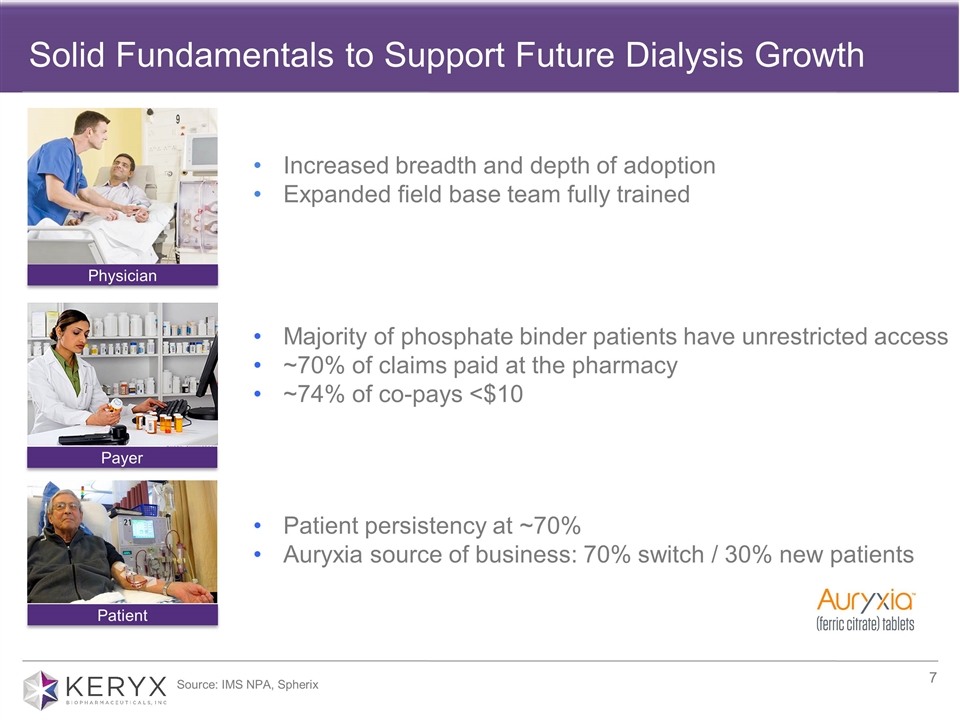
Solid Fundamentals to Support Future Dialysis Growth Physician Payer Patient Increased breadth and depth of adoption Expanded field base team fully trained Majority of phosphate binder patients have unrestricted access ~70% of claims paid at the pharmacy ~74% of co-pays <$10 Patient persistency at ~70% Auryxia source of business: 70% switch / 30% new patients Source: IMS NPA, Spherix
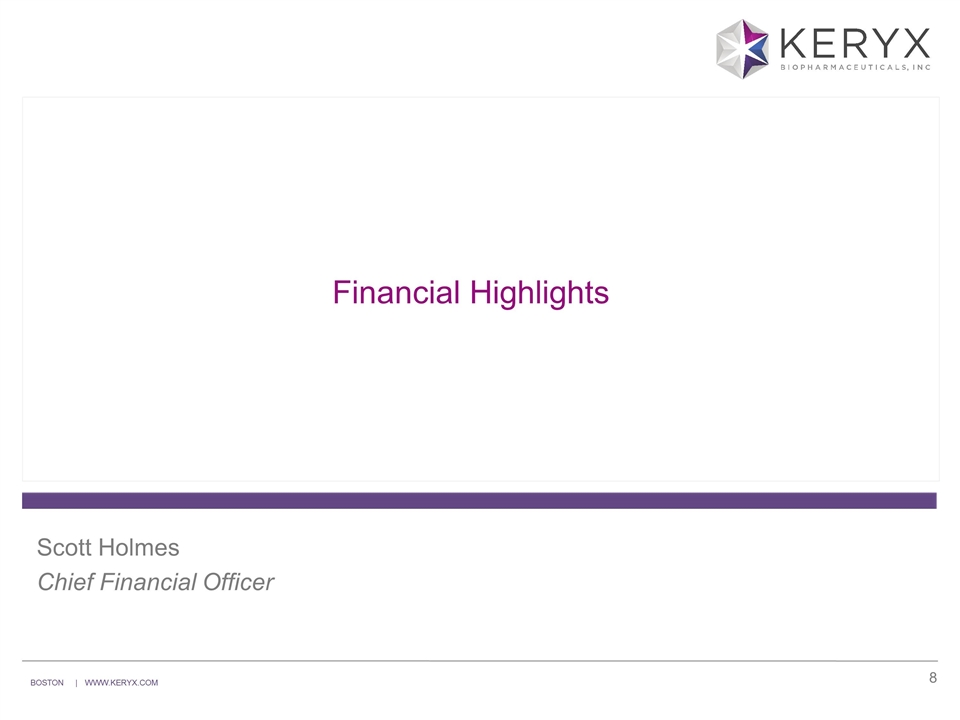
Financial Highlights Scott Holmes Chief Financial Officer
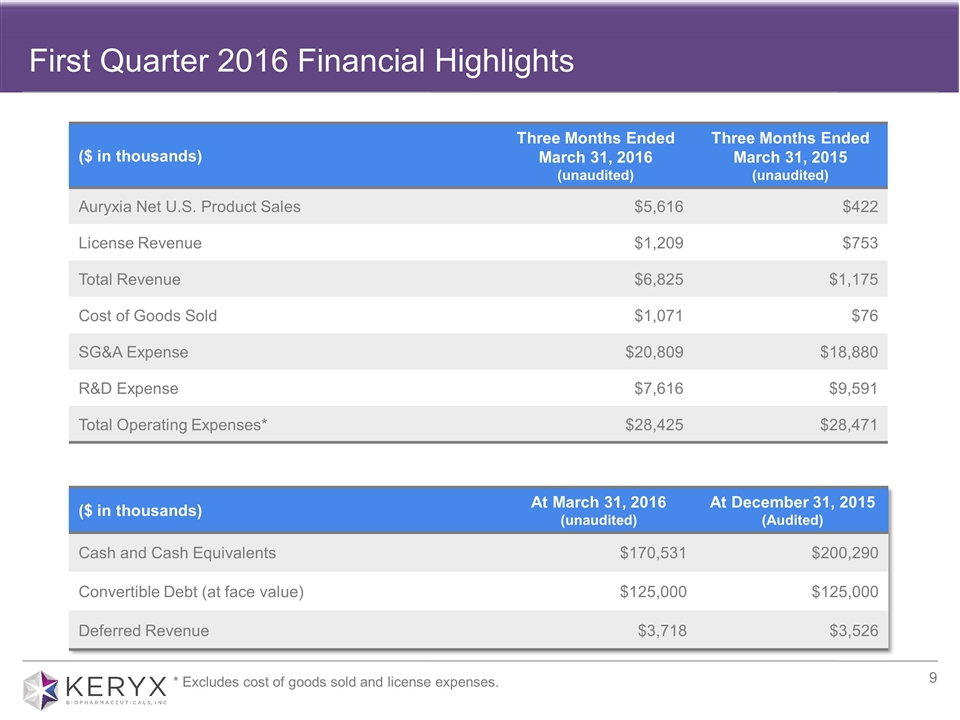
First Quarter 2016 Financial Highlights ($ in thousands) Three Months Ended March 31, 2016 (unaudited) Three Months Ended March 31, 2015 (unaudited) Auryxia Net U.S. Product Sales $5,616 $422 License Revenue $1,209 $753 Total Revenue $6,825 $1,175 Cost of Goods Sold $1,071 $76 SG&A Expense $20,809 $18,880 R&D Expense $7,616 $9,591 Total Operating Expenses* $28,425 $28,471 ($ in thousands) At March 31, 2016 (unaudited) At December 31, 2015 (Audited) Cash and Cash Equivalents $170,531 $200,290 Convertible Debt (at face value) $125,000 $125,000 Deferred Revenue $3,718 $3,526 * Excludes cost of goods sold and license expenses.

Reconciliation of Total Operating Expenses to Cash Operating Expenses (Non-GAAP) ($ in thousands) Three Months Ended March 31, 2016 (unaudited) Three Months Ended March 31, 2015 (unaudited) SG&A Expense $20,809 $18,880 R&D Expense $7,616 $9,591 Total Operating Expenses* $28,425 $28,471 Less: non-cash expenses Stock compensation expense 3,293 4,321 Amortization and depreciation 261 138 Non-cash commercial expenses (samples etc.) 1,005 24 Total Cash Operating Expenses (Non-GAAP) $23,866 $23,988 * Excludes cost of goods sold and license expenses.
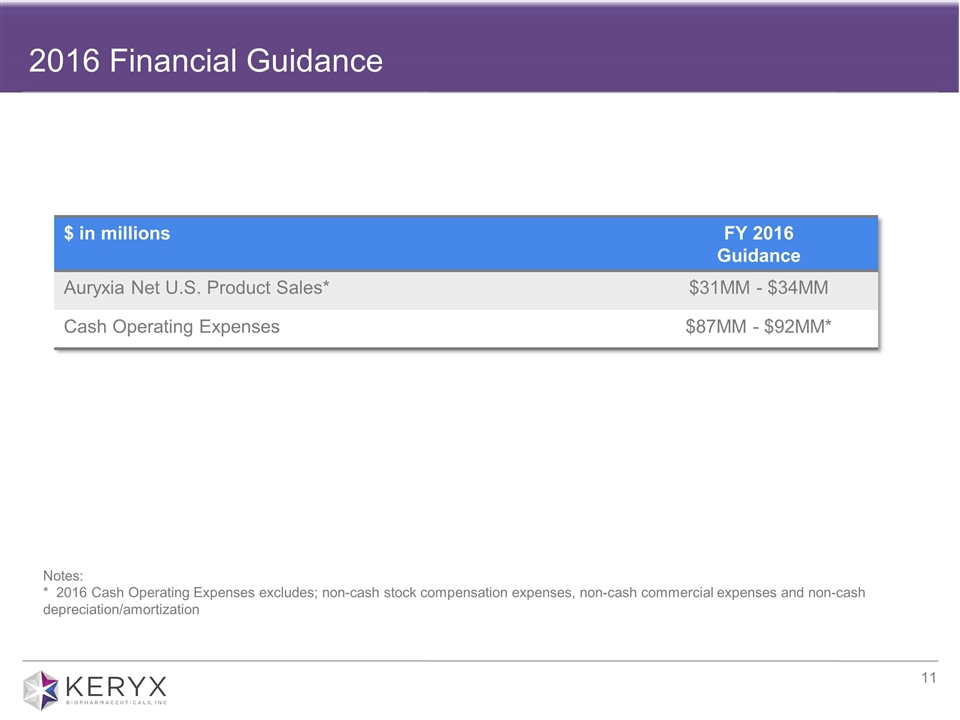
2016 Financial Guidance $ in millions FY 2016 Guidance Auryxia Net U.S. Product Sales* $31MM - $34MM Cash Operating Expenses $87MM - $92MM* Notes: * 2016 Cash Operating Expenses excludes; non-cash stock compensation expenses, non-cash commercial expenses and non-cash depreciation/amortization
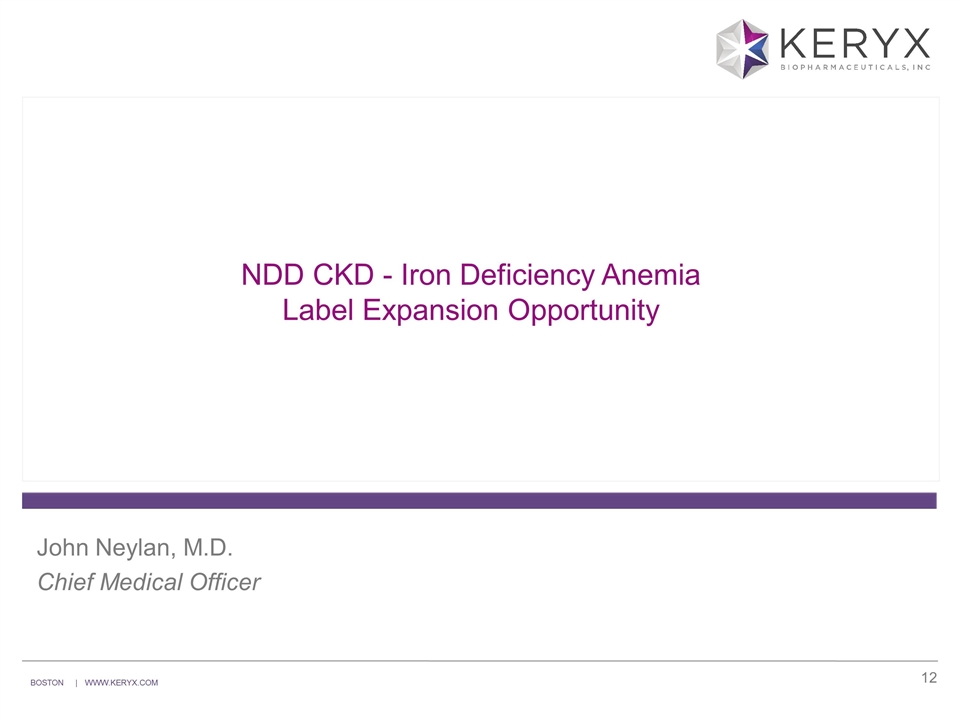
NDD CKD - Iron Deficiency Anemia Label Expansion Opportunity John Neylan, M.D. Chief Medical Officer
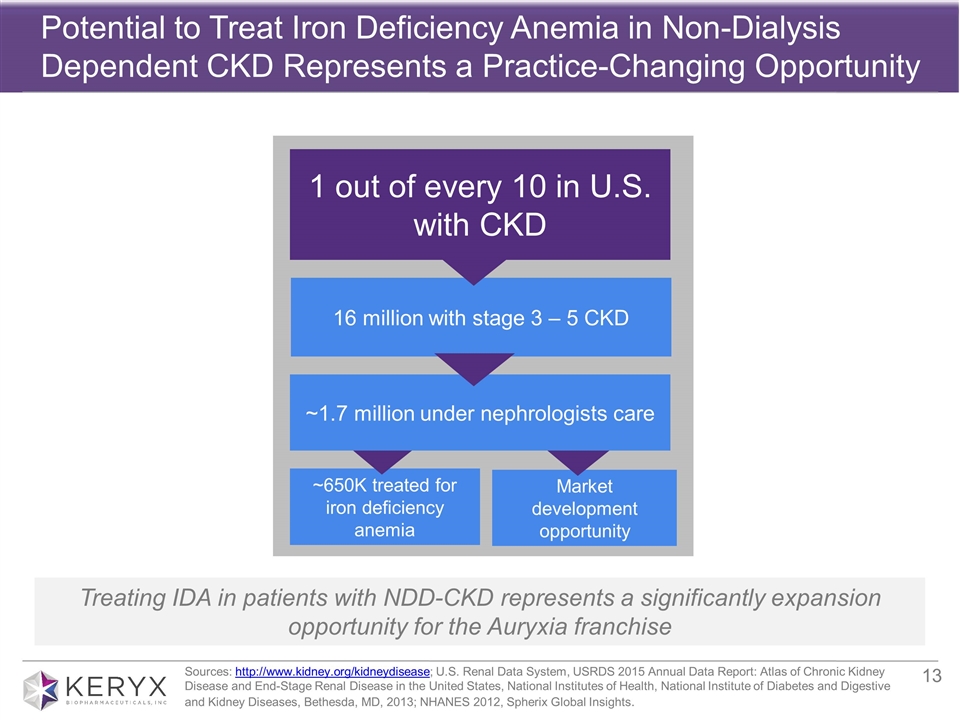
Potential to Treat Iron Deficiency Anemia in Non-Dialysis Dependent CKD Represents a Practice-Changing Opportunity Sources: http://www.kidney.org/kidneydisease; U.S. Renal Data System, USRDS 2015 Annual Data Report: Atlas of Chronic Kidney Disease and End-Stage Renal Disease in the United States, National Institutes of Health, National Institute of Diabetes and Digestive and Kidney Diseases, Bethesda, MD, 2013; NHANES 2012, Spherix Global Insights. 1 out of every 10 in U.S. with CKD 16 million with stage 3 – 5 CKD ~650K treated for iron deficiency anemia Market development opportunity ~1.7 million under nephrologists care Treating IDA in patients with NDD-CKD represents a significantly expansion opportunity for the Auryxia franchise
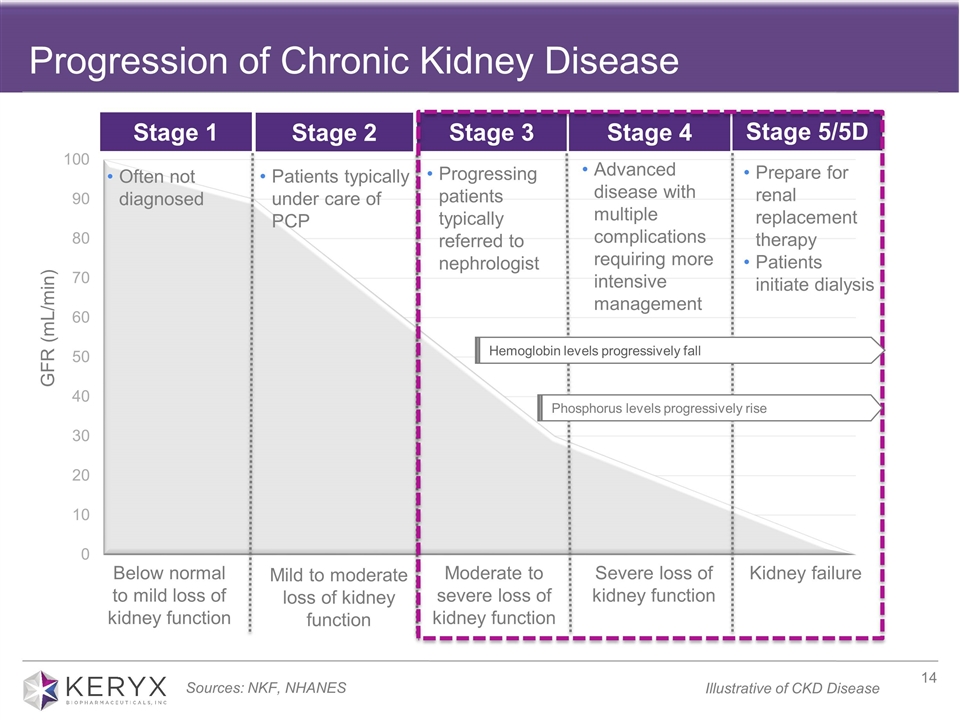
Progression of Chronic Kidney Disease Progressing patients typically referred to nephrologist Prepare for renal replacement therapy Patients initiate dialysis GFR (mL/min) Often not diagnosed Patients typically under care of PCP Moderate to severe loss of kidney function Severe loss of kidney function Kidney failure Below normal to mild loss of kidney function Mild to moderate loss of kidney function Stage 3 Stage 4 Stage 5/5D Stage 1 Stage 2 Hemoglobin levels progressively fall Sources: NKF, NHANES Advanced disease with multiple complications requiring more intensive management Phosphorus levels progressively rise Illustrative of CKD Disease
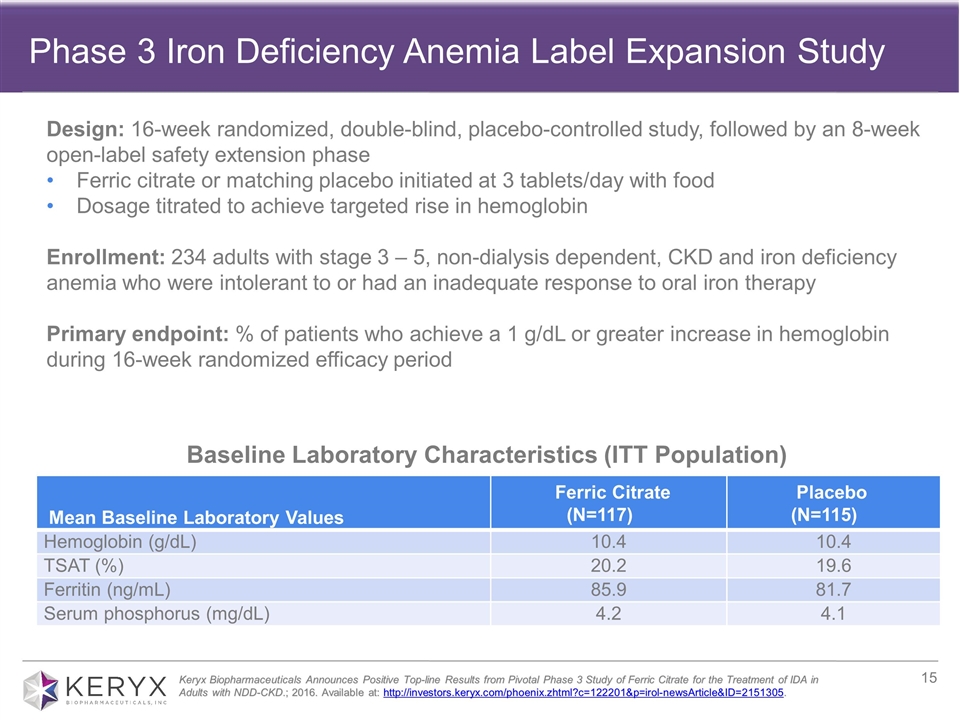
Baseline Laboratory Characteristics (ITT Population) Mean Baseline Laboratory Values Ferric Citrate (N=117) Placebo (N=115) Hemoglobin (g/dL) 10.4 10.4 TSAT (%) 20.2 19.6 Ferritin (ng/mL) 85.9 81.7 Serum phosphorus (mg/dL) 4.2 4.1 Keryx Biopharmaceuticals Announces Positive Top-line Results from Pivotal Phase 3 Study of Ferric Citrate for the Treatment of IDA in Adults with NDD-CKD.; 2016. Available at: http://investors.keryx.com/phoenix.zhtml?c=122201&p=irol-newsArticle&ID=2151305. Design: 16-week randomized, double-blind, placebo-controlled study, followed by an 8-week open-label safety extension phase Ferric citrate or matching placebo initiated at 3 tablets/day with food Dosage titrated to achieve targeted rise in hemoglobin Enrollment: 234 adults with stage 3 – 5, non-dialysis dependent, CKD and iron deficiency anemia who were intolerant to or had an inadequate response to oral iron therapy Primary endpoint: % of patients who achieve a 1 g/dL or greater increase in hemoglobin during 16-week randomized efficacy period Phase 3 Iron Deficiency Anemia Label Expansion Study

*Sustained treatment effect on Hgb was defined as a mean change from baseline ≥0.75 g/dL over any 4-week time period during the 16-week, randomized efficacy period, provided that an increase of at least 1.0 g/dL had occurred during that 4-week period. Randomized Efficacy Period (16 Weeks) Ferric Citrate (N=117) Placebo (N=115) P value Primary Endpoint (ITT Population) Proportion of patients achieving an increase in hemoglobin of ≥1.0 g/dL at any time point (%) 52.1 19.1 <0.001 Secondary Endpoints (Pre-specified) Mean change in hemoglobin (g/dL) 0.75 ‒0.08 <0.001 Mean change in TSAT (%) 17.8 ‒0.6 <0.001 Mean change in ferritin (ng/mL) 162.5 ‒7.7 <0.001 Proportion of patients with a durable response* (%) 48.7 14.8 <0.001 Mean change in serum phosphorus (mg/dL) ‒0.43 ‒0.22 0.02 Mean dose in the ferric citrate group was 5 tablets/day Keryx Biopharmaceuticals Announces Positive Top-line Results from Pivotal Phase 3 Study of Ferric Citrate for the Treatment of IDA in Adults with NDD-CKD.; 2016. Available at: http://investors.keryx.com/phoenix.zhtml?c=122201&p=irol-newsArticle&ID=2151305. IDA Phase 3 Top-line Results: Primary and Secondary Endpoints Statistically significant differences between ferric-citrate-and placebo-treated patients for the primary and all pre-specified secondary endpoints
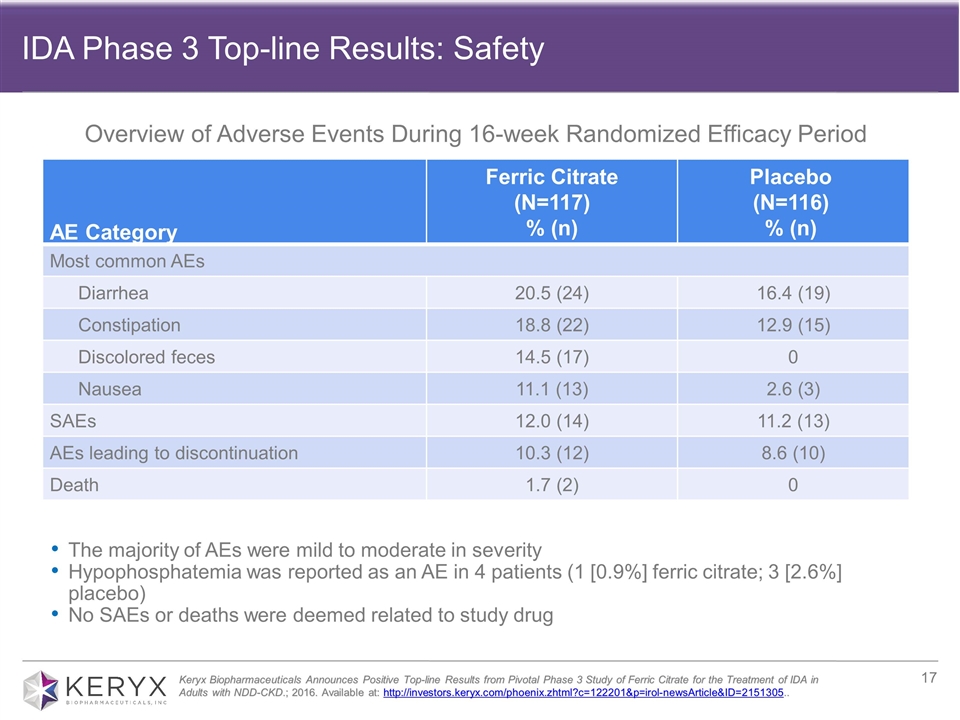
AE Category Ferric Citrate (N=117) % (n) Placebo (N=116) % (n) Most common AEs Diarrhea 20.5 (24) 16.4 (19) Constipation 18.8 (22) 12.9 (15) Discolored feces 14.5 (17) 0 Nausea 11.1 (13) 2.6 (3) SAEs 12.0 (14) 11.2 (13) AEs leading to discontinuation 10.3 (12) 8.6 (10) Death 1.7 (2) 0 The majority of AEs were mild to moderate in severity Hypophosphatemia was reported as an AE in 4 patients (1 [0.9%] ferric citrate; 3 [2.6%] placebo) No SAEs or deaths were deemed related to study drug Keryx Biopharmaceuticals Announces Positive Top-line Results from Pivotal Phase 3 Study of Ferric Citrate for the Treatment of IDA in Adults with NDD-CKD.; 2016. Available at: http://investors.keryx.com/phoenix.zhtml?c=122201&p=irol-newsArticle&ID=2151305.. Overview of Adverse Events During 16-week Randomized Efficacy Period IDA Phase 3 Top-line Results: Safety
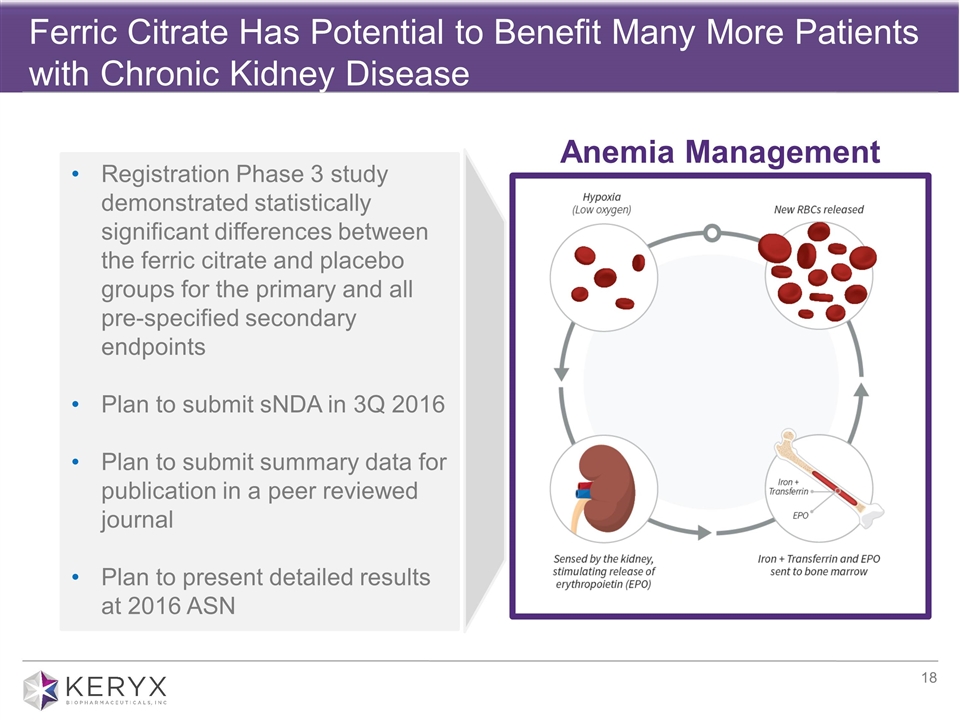
Ferric Citrate Has Potential to Benefit Many More Patients with Chronic Kidney Disease Anemia Management Registration Phase 3 study demonstrated statistically significant differences between the ferric citrate and placebo groups for the primary and all pre-specified secondary endpoints Plan to submit sNDA in 3Q 2016 Plan to submit summary data for publication in a peer reviewed journal Plan to present detailed results at 2016 ASN
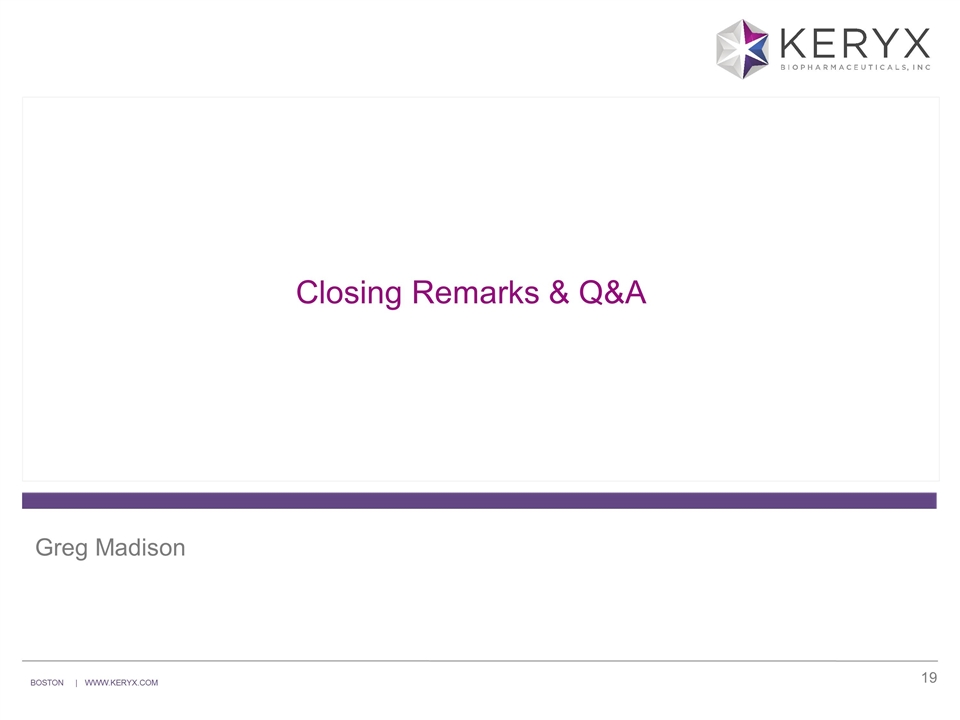
Closing Remarks & Q&A Greg Madison

A Potential New Treatment Category for CKD Phosphate Management Anemia Management Auryxia is currently indicated for the control of serum phosphorus levels in CKD patients on dialysis; Ferric citrate is being evaluated for use in non-dialysis dependent CKD patients as a treatment for iron deficiency anemia.

Priorities for the Future and Progress Toward Potential Auryxia Label Expansion Drive Auryxia’s path to success in dialysis: Increase awareness Drive breadth and depth of prescribing Finalize Ph 3 IDA NDD-CKD trial and report top-line results Submit sNDA Begin potential IDA/NDD-CKD launch activities Continue launch preparedness activities Establish Auryxia as a new treatment category Understand if we can better manage kidney patient care during transition to dialysis with Auryxia treatment in the non-dialysis dependent CKD community 2017 and Beyond 2016 Auryxia is currently indicated for the control of serum phosphorus levels in CKD patients on dialysis; Ferric citrate is being evaluated for use in non-dialysis dependent CKD patients as a treatment for iron deficiency anemia.
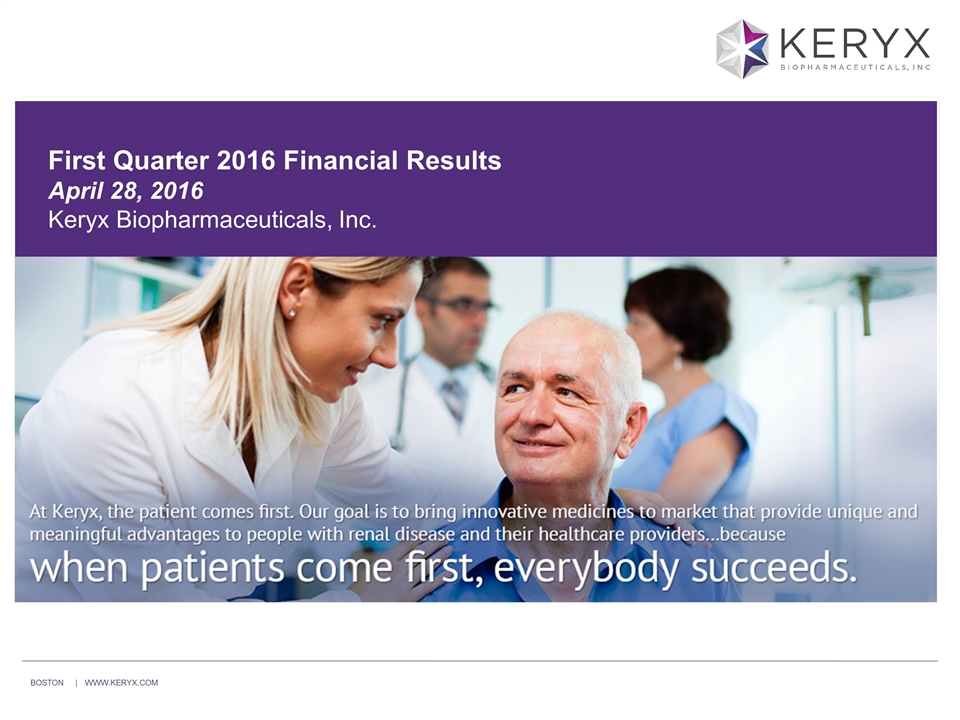
First Quarter 2016 Financial Results April 28, 2016 Keryx Biopharmaceuticals, Inc.
